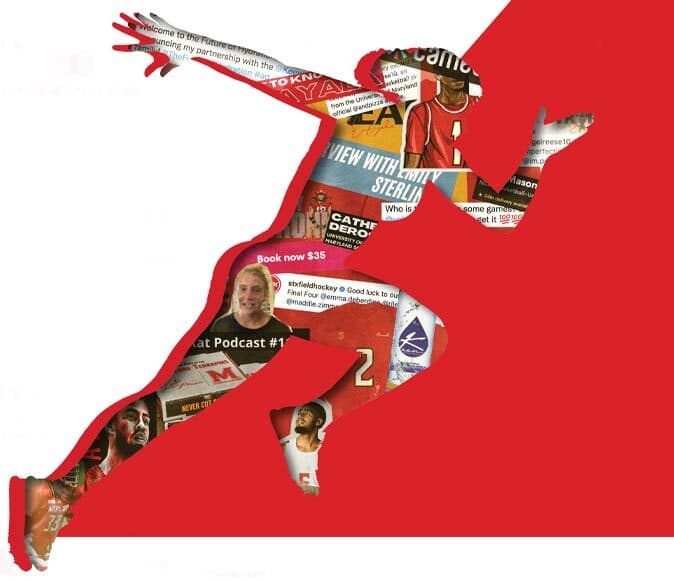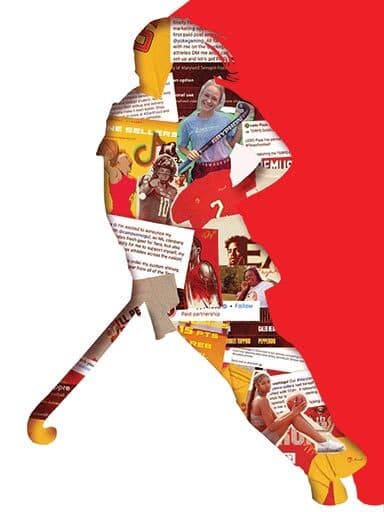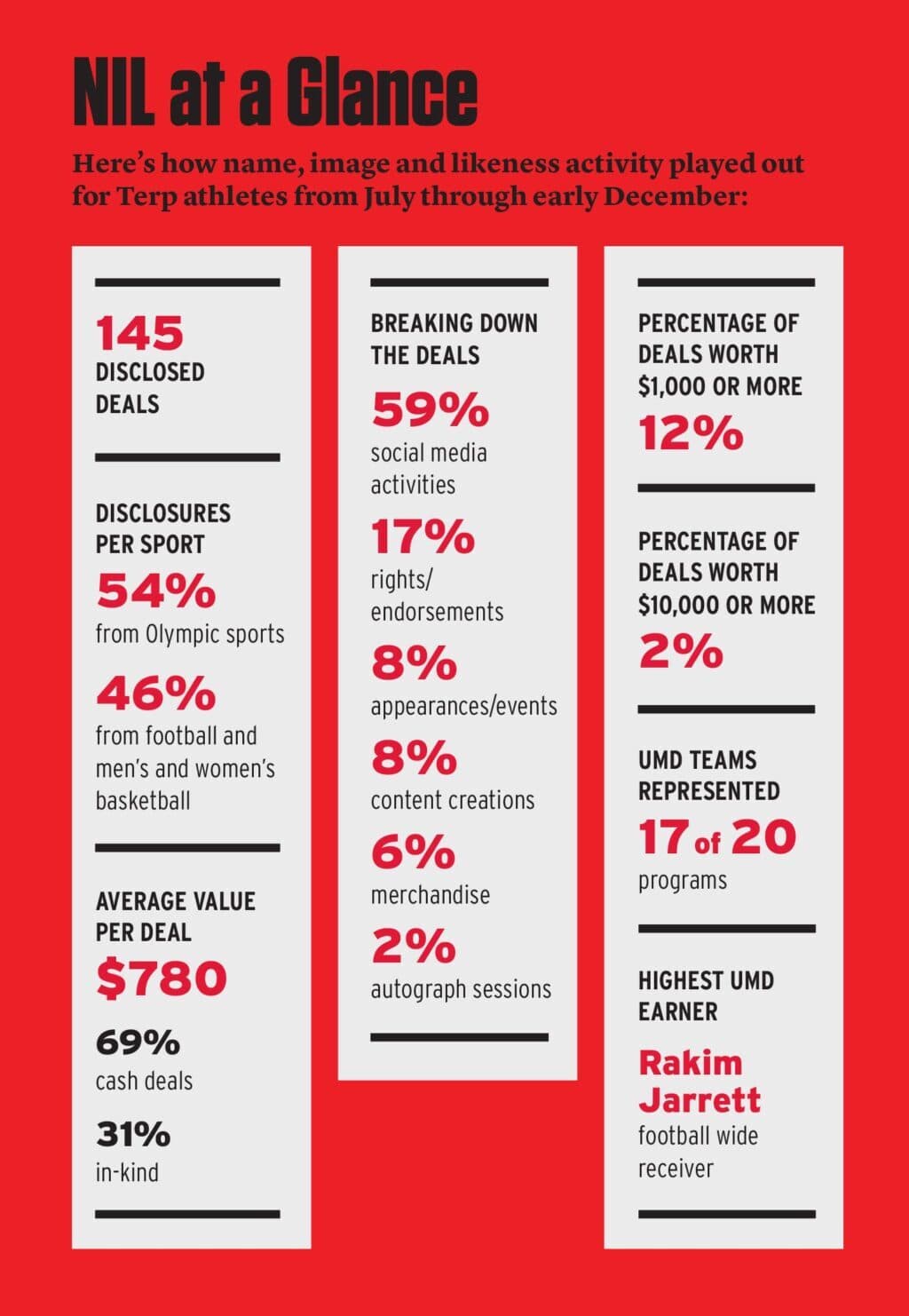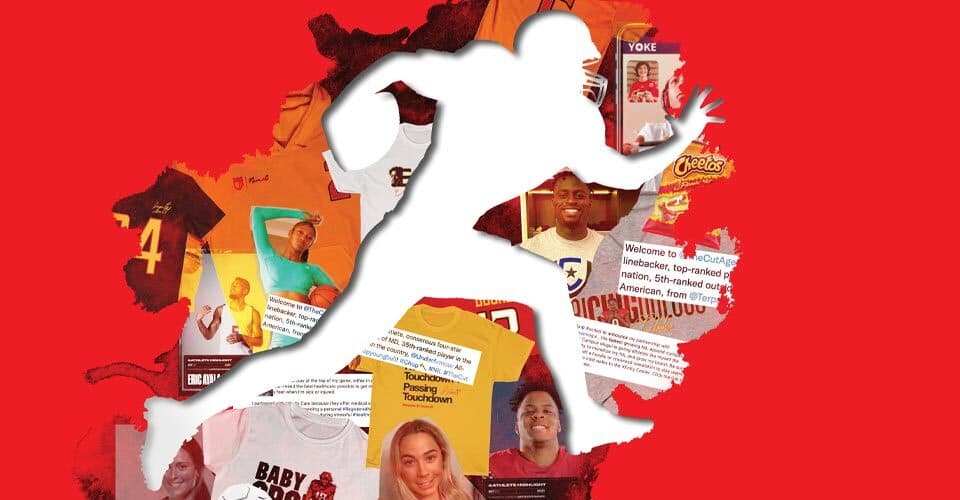A Brand New World
New rules allowing college athletes to profit from endorsement deals are changing the game for universities nationwide. UMD aims to be the first with a playbook.
By Liam Farrell | Photo collages by Valerie MorganSLIPPERY, SPEEDY WIDE RECEIVER Rakim Jarrett was ranked among the nation’s top 100 high school players in late 2019 when the five-star Washington, D.C., prospect surprised the college football recruiting world by flipping his commitment from Louisiana State to the hometown Terps.
Now a sophomore, Jarrett has shown flashes of his potential, racking up 144 yards and two touchdowns against Penn State in 2020 and a crucial 60-yard score against West Virginia last season. But his off-the-field activities—signing an agent from marketing powerhouse Creative Arts Agency, selling personalized T-shirts and endorsing Jimmy’s Famous Seafood—might be even more game-changing.
Until last July, any of those deals would have been major NCAA violations for both the player and program. Now, Jarrett and other Terp athletes are members of the first generation that can capitalize on their fame while still in college following the NCAA’s suspension of rules preventing athletes from profiting off their own “name, image and likeness,” a landmark shift in the governing body’s history.
The “NIL” decision followed more than a century of debates and lawsuits over educational and financial benefits for college athletes, as well as a more recent burst of state-by-state legislation ending restrictions on earning money from their popularity. The University of Maryland has sought to be a national leader in this new marketplace, but navigating it has required constant vigilance: Should athletes be allowed to use their schools’ official marks and logos? What are the pitfalls if a player endorses beer or liquor? What happens when sponsors and agents are added to the chorus of voices in a student’s ear?
So far, the only certain answer is that it will take years to fully grasp how NIL will shift foundational practices.
“It’s like a perfect storm right now for those who have been pushing change,” says Damon Evans, the Barry P. Gossett Director of Athletics for the University of Maryland. “We need to embrace all this stuff and figure out how best we adjust and adapt.”
For Jarrett, UMD’s biggest earner so far, it most immediately means he could see up to $60,000 from endorsement deals during his sophomore year. The NFL hopeful, who is currently squirrelling away his earnings, sees his increasingly lucrative personal brand as validation for making his name seven miles from home rather than banking on traditional football bluebloods.
“It shows that it can be done,” he says.
THE FIGHT OVER what students should earn for athletic achievements was already well underway by 1852, when a railroad company tried to spur tourism by paying for Harvard and Yale to row against each other on a New Hampshire lake—the first intercollegiate contest in the United States.
American collegiate athletics were born out of the British “amateur ideal,” a philosophy that, even if never completely honored, prized schoolboy recreation over results. But disapproval of salaries, coaching and even practice also doubled as a way to keep lower socioeconomic classes off the pitch, an uneasy fit in a New World that prided itself on self-made success and moral development through fierce competition.
So the lofty stated principles of the NCAA, founded in 1906, were always in tension with how colleges chased success in high-stakes sports. From cushy dorms and exotic vacations to outright salaries and commissions from local cigarette sales, early 20th-century benefits constantly raised worries that amateur competition had been breached by professionalism. In 1929, a landmark report from the Carnegie Foundation denounced perks of the era from “costly sweaters and extensive journeys in special Pullman cars” to broader practices including high school recruiting and admissions offices prioritizing athletic skill over scholastic aptitude.
Yet inch by inch, allowances that would have once horrified proponents of amateurism were integrated into college sports. The so-called Sanity Code of 1948 let schools pay athletes’ tuition, but an effort to expel a targeted “Sinful Seven” schools, including the University of Maryland, for going beyond that failed two years later—a tacit acknowledgment that everyone else was just as guilty.
In 1957, the NCAA allowed members to add room, board and fees, essentially covering athletes’ living and educational expenses. But another clause was approved as well, stating “a student-athlete’s picture may not be associated with a commercial product in such a way as to imply endorsement, nor may he receive remuneration.”
Not surprisingly, tensions increased between the NCAA, universities, athletes and advocates when licensing revenue exploded in the 1980s and 1990s. While the sanctioned money available to students remained largely limited to scholarships, the television deals, stadium gate receipts and coaches’ salaries continued on a far steeper climb.
Video games proved the modern flashpoint. Former UCLA basketball star Ed O’Bannon filed an antitrust lawsuit over his digital likeness being used without permission in the 2009 edition of Electronic Arts’ NCAA Basketball franchise. The qualified successes of his and additional legal challenges amplified the NIL conversation in media, government and player circles. Then in 2019, California became the first state to allow college athletes to earn endorsement money. With no competing federal or NCAA policy, the opening whistle had blown for states to run their own NIL race.

BY EARLY 2021, when legislators in Annapolis began to consider the issue in earnest, UMD athletics officials were already drafting their NIL playbook. The university had been working since 2019 with the sports branding company Opendorse, which also links professional athletes with endorsement opportunities, to help provide photos, videos and graphics that Terps can use to promote themselves and connect with fans on social media. With NIL on the way, an additional four-year partnership was signed to collaborate on this new process.
While neither the athletic department nor Opendorse can arrange deals for individual athletes, the company’s online platform estimates someone’s fair market value; helps companies and brands identify potential clients based on factors such as location, sport and size of social media following; and informs the institution about student deals.
T.J. Ciro ’02, senior vice president and head of partnerships for Opendorse, says UMD showed a “progressive mindset.”
“A lot of schools were waiting for the NCAA to provide more direction,” he says. “Maryland was definitely one of the early adopters.”
In April, the Maryland General Assembly passed the Jordan McNair Safe and Fair Play Act. Named after the UMD football player who collapsed from heatstroke and died following a 2018 team workout, the legislation bundled together NIL regulations and safety requirements for state intercollegiate athletics programs.
The Maryland NIL rules won’t take effect until July 1, 2023, unless the General Assembly votes to implement them sooner during the annual 90-day legislative session that began in January. But the NCAA suspended its compensation ban last July 1, allowing athletes to earn endorsements pursuant to individual state, conference and school oversight.
So without many guidelines, UMD has been feeling its way through: New NIL deals have to be disclosed to the university within 14 days of an agreement; students can sign with competitors of a university sponsor (i.e., Nike vs. Under Armour, Coke vs. Pepsi), but tobacco companies, adult entertainment and anything involving NCAA-banned substances—including medical marijuana and other cannabis products—are off-limits; and students with products or ads using official trademarks and logos are subject to paying UMD its standard 12% royalty rate.
“I saw this as a win-win,” says Evans, a former Georgia wide receiver. “Why shouldn’t (athletes) have the right?”
THE BEGINNING OF the endorsement era has had no shortage of heady deals: an Oregon defensive lineman started his own cryptocurrency; Arby’s handed out $500 to the first 200 Division I running backs (“#ArbysRBs”) who posted a video saying, “Tonight, I’m getting Arby’s;” a Kentucky freshman basketball player rolled up to campus in a Porsche after inking an agreement with a luxury car dealership; a protein bar company struck an agreement with the entire BYU football team, even paying walk-ons enough to cover tuition.
Students in niche sports are finding opportunities as well. Brooke DeBerdine, a Terp midfielder, signed a deal with Longstreth Field Hockey to represent its Gryphon line of sticks, bags, protective gear and shoes. A national team member hoping to compete in the 2024 Summer Olympics, DeBerdine says NIL has provided valuable business and brand building experience prior to leaving College Park.
“It’s a good time to be able to do that before having a complete lifestyle change (after graduation),” she says. “It was definitely exciting, but also overwhelming.”
DeBerdine praises Maryland Athletics’ efforts to teach her and other athletes how to navigate the new rules and UMD’s tools to support them. For example, in October, it launched a licensing program with the Brandr Group so athletes can collectively opt into an agreement and legally use the university’s trademarks and logos on their own products.
Opendorse, which has also partnered with schools such as Clemson, Florida, Texas and Ohio State, released an early snapshot of the bottom line for athletes who have secured deals through its platform. From July 1 through Nov. 30, the Big Ten Conference, which includes Maryland, was tops in the country in terms of total compensation and activity. Football earned about 48% of the available compensation, trailed by women’s and men’s basketball, at about 25% and 17%, respectively. The average compensation for Division I athletes was $1,256, compared to $75 for Division II and $37 for Division III.
While an athlete’s celebrity might attract a first deal, Ciro says, the students collecting multiple endorsements are the ones putting time and effort into their promotions. Fresno State basketball players Haley and Hanna Cavinder were able to leverage their millions of followers on TikTok to land a deal with Boost Mobile, but Ciro says companies also see value in the tens of thousands of less famous options whose audiences may be smaller but are more invested in their success.
“Every person who follows them, follows them for a reason,” he says. “When you start to scale that (influence) across the country, you can see why brands are excited.”

EVEN IF TERP ATHLETES won’t be bartending at Bentley’s or driving Shuttle-UM buses anytime soon, it’s clear that burgeoning stars such as basketball player siblings Julian and Angel Reese will have plenty of available gigs, with Julian endorsing NFL quarterback Tom Brady’s new apparel line and Angel doing Instagram promotions for Giant Food, Starface skin care and Prissy Athletics clothing.
At the start of NIL, women’s basketball Coach Brenda Frese wondered how her already-busy collegiate players would respond to its commercial demands. But so far, Frese says, NIL syncs with her roster’s existing social media habits and has given players positive opportunities to build their personal brands.
“It was long overdue for players to use their own rights,” she says. “They have done a really good job knowing how much they can take on. It’s just another thing they have to balance.”
Frese says NIL will also pay dividends for the visibility of women’s basketball and a successful program like UMD, which is located in a large media market, plays high-profile matches on national television and is consistently in the hunt for national championships.
“The future is really bright,” she says. “I’m super optimistic for our girls.”
And it’s undeniable that NIL has become a consideration for sought after recruits when they pick a program. While many talented football players finish their high school requirements a semester early to get a jump on college practice and conditioning in the spring, one Kentucky high school player even left his team mid-season to head to Rutgers and ink a reportedly six-figure NIL deal.
But, among many other questions, how sustainable the most lucrative agreements will be at the individual or group level is still to be determined—the volatile and inconsistent nature of college sports inevitably dims some of August’s future stars into December’s afterthoughts. One high school quarterback enrolled a full year ahead of schedule at Ohio State with endorsements and a $1.4 million autograph contract, but decided to transfer to Texas after recording just two snaps in his nascent Columbus career.
On the national stage, the NCAA has been lobbying Congress to pass a framework that would include mandated financial counseling on tax and scholarship implications and ensure a fair, competitive environment across jurisdictions. Much like their predecessors, the organization’s leaders also say they are trying to preserve the unique dual athletic-educational character of collegiate competition and protect amateurs who should make just as many gains in lecture halls as in weight rooms.
“We already are hearing from athletics programs giving evidence of a negatively changed recruiting landscape,” NCAA President Mark Emmert told the House Subcommittee on Consumer Protection and Commerce in a September hearing. “As new states rush to keep up with the states that have enacted NIL reform, we are likely to see a ‘race to the bottom,’ with each state trying to ensure that its schools have a competitive advantage over other states until eventually the protections for student-athletes become so thin that there is little discernible difference between college athletes and professional sports figures.”
Other shifting factors also make it hard to predict NIL’s potentially seismic effects. Fights over the College Football Playoff ’s format reignite just about every year; conference membership switches and an explosion in transfers and COVID-19-era eligibility tweaks have further complicated team management; coaching contracts have taken another stratospheric leap, further upping competition between universities for staff and ballooning salary and contract buyout obligations.
The Supreme Court has signaled a willingness to hear more challenges to traditionally accepted NCAA practices, and in September, National Labor Relations Board General Counsel Jennifer Abruzzo issued a memo saying that student-athletes should be afforded the same protections, including the right to unionize, as other employees—a classification that, if officially conferred, would tear the last threads connecting America’s stadiums to the 19th-century fields of Oxford and Cambridge.
For his part, the Terps’ Rakim Jarrett is trying not to let the lure of financial success go to his head. In July, he jokingly tweeted (with a skull emoji), “Didn’t know I was going from high school to paying taxes!!” Yet in looking at his surprise financial opportunities once only available to the pros, he allows himself a moment to consider the trailblazing route he’s already running for future players in red, black and gold.
“I don’t want to think too far ahead,” Jarrett says. “(But) that’ll be pretty cool to think back on.” TERP

0 Comments
Leave a Reply
* indicates a required field

